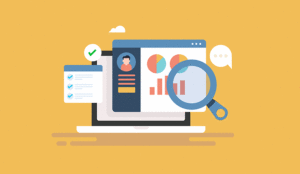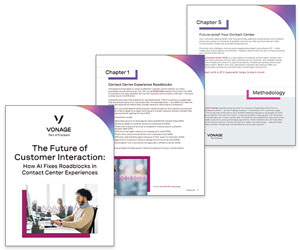Scott Rigdon at Vonage explains what Customer Data Management is and how it can be used to drive personalization.
What Is Customer Data Management (and How Does It Drive Personalization)?
You can sum up today’s customers with one word: Demanding.
They expect brands to remember them — to know that they prefer pink shirts or mid-century style furniture or classic rock on vinyl; that they usually (but not always) shop on their phone; that they’re open to recommendations and new-product alerts (and reeeally like discounts).
Using data like this to create personalized communications can boost customer experience and loyalty. And having a solid customer data management system in place helps make it all possible.
What Is Customer Data Management?
Customer data management is the process where businesses gather, store, update, access, and — most importantly for personalization — analyze information from their customers.
The ultimate goal is to ensure that the data used by customer-facing teams — sales, marketing, account management — is updated, easily accessible, and “clean,” or free of redundancies, so you can wring the maximum benefits out of it.
This same data is fed into marketing automation platforms and other customer-facing software that directly influence lead generation, nurturing, and time to close — in other words, company revenue.
What Is Personalization?
The short answer is, it depends — on the channel, how it’s being used, and more. For example, most sales and prospecting email automation systems allow the inclusion of variables like the recipient’s first name, their title, the company name, etc., along with copy “snippets” that can mention use cases or pain points that resonate with certain personas.
But this isn’t so much personalization as it is the illusion of personalization — although it’s definitely a step up from the “Dear Sir or Madam” efforts of the past.
Data management and analysis let marketers get closer to real personalization. They can take a piece of content and make it more useful for a customer, more targeted at the customer’s interests, needs, and wants.
According to a 2021 BCG report, companies that can deliver more personalized customer campaigns can not only increase sales by 6% to 10%, but continuing that personalization post-sale can also lead to longer customer lifecycles and better value per customer through increased upsells and renewals.
Today, advanced analytics that incorporate tools like AI and machine learning are making it possible to better manage the barrage of customer data that flows into a company from multiple channels — and then use that information to add specific messaging to their marketing that will hopefully click with individual customers.
There are limits to how personal this personalization can be — no one invites a brand to their backyard cookout. But by using customer data management, companies can consistently deliver engaging, meaningful, personalized content that has, at the very least, a human touch.
Here’s How Some Companies Use Data for Personalization
To a certain extent, personalization is more like “persona”-lization — it’s probably impossible for businesses to truly know Each. Individual. Customer. But they can often come surprisingly close. Here are a few examples:
Grammarly
This app that helps catch grammar mistakes and improve writing sends weekly reports to users on how their writing has improved. The reports include the number of words written in that week, how many mistakes were made, potential areas for improvement, and more.
Hulu
The online streaming service collects a huge amount of data from customers, including not only what they watch but when they watch it. That information helps create targeted recommendations, which users can either like or dislike.
Enfagrow
This baby formula company collects data from customers about their baby’s age to proactively reach out with age-appropriate product recommendations. Personalized emails for each stage of a baby’s development provide advice, activities, and discounts for products that match a baby’s age.
Very
The UK-based fashion brand understands that weather impacts what people buy beyond factors like color and style. So they integrate local weather patterns into their personalization efforts, highlighting clothing items that match the local climate based on a user’s location.
How Can Businesses Gather Data …
Customers interact with brands through multiple channels, both online and offline. And all of these touchpoints — store visits, social media interactions, website visits, digital asset downloads, targeted ad responses, survey responses, and more — generate valuable data.
There are three basic ways a company can gather information about its customers:
- Ask for it directly — for example, customers give up this information when they open an account or make a purchase online;
- indirectly track customers, for example through web cookies to determine what pages a customer has visited; or
- add other third-party sources to your own.
Sophisticated technologies like marketing automation tools, CRM platforms, data management platforms, and cookies provide tons of data.
Here are some of the most popular data gathering methods today:
Online Marketing Analytics
Customers are asked to fill out a form that includes some personal information. The insights drawn from this information are used to personalize customer journeys and improve customer service.
Loyalty Programs
Customers collect points with every purchase and swap them for some rewards. In this way, businesses can create buyer profiles with detailed consumer preferences and habits.
Games
Users interact with a brand through mini-games that pay off with incentive awards. The addictive nature of games allows companies to continue to collect data as long as the customer stays in the game.
Social Media Activity
Users spend an average of about 2.5 hours a day on social media, sharing videos, texts, photos, and other sources of personal information.
… And Not Seem Creepy?
The problem isn’t so much with the collection of data. It’s how transparent organizations are when they do gather it.
The key is consent. Consumers feel uncomfortable when brands target them using information which they never intended to share. So businesses need to be straightforward in their disclosures.
Customers Are Open to Sharing Their Information — But They Want Something in Return
There’s no doubt that consumers worry about their online privacy and the potential abuse of their personal data.
Yet their behavior often contradicts those claims of anxiety. A study reports that people are increasingly open to sharing some private information online — credit card details, telephone numbers, addresses, etc. — in return for convenience or financial benefits.
While they’re uneasy about data sharing in theory, they recognize the practical benefits of doing so — including enjoying more personalized interactions.
Why Do Businesses Need Customer Data Management?
The sheer volume of available data makes having a system in place to manage it hugely important. To stay ahead of the customer-centricity curve, businesses need to unify this data to create a single, personalized customer view based on the most up-to-date information.
No human can read through line after line of customer data day after day — and even if they could, they wouldn’t make much of a dent. Computers, however, can sift through this data more quickly and efficiently, without a break, 24/7/365.
Plus, as machine learning algorithms and other forms of AI proliferate and improve, data analytics becomes an even more powerful method for breaking down the mass of data into manageable tidbits of actionable insights.
Best Practices in Customer Data Management
Here are a few best practices for an effective CDM program that drives personalization.
Cultivate Data-Centric Customer Centricity
The basic purpose of CDM is to deliver better customer experiences. For this, the strategy should be designed from the outside in — in other words, from the customer’s perspective and following their buying journey.
A CDM strategy that includes a customer-centric culture ensures that all data is used to improve customer satisfaction, while data-centricity means that the data is captured from all interactions and is as fresh as technologically possible.
Commit to Customer Data Security
Capturing customer data to enhance experiences is a great benefit for any enterprise. But a single slip in data security can undo all these benefits and attract negative attention from the media or law enforcement.
As data capture rises, so do data breaches. It’s the responsibility of the data security team to ensure that all customer data is captured and secured using encryption and/or security software.
In addition, it’s important to establish a company-wide data governance policy, outlining how data is captured and stored and who has access to it.
Avoid Over-Collecting Data
There really can be too much of a good thing when it comes to data. Know what questions you’re trying to answer and problems you’re trying to solve, and then focus collection efforts in those areas.
Resist the urge to collect data “just in case” you need it in the future, without specific initiatives in mind. Plus, it’s vital to categorize and tag data so you can easily access and activate it.
Invest in Customer Journey Mapping
A customer journey map is a visual description of every experience a customer has with your brand. Although it isn’t meant to be a 100% accurate representation, it gives marketers crucial insights into how customers interact with the brand at each touchpoint, letting them deliver the most relevant customer experience.
Customer Data Management and Personalization Go Hand-in-Hand
You want your customers to feel like you’re having a conversation with them, instead of talking at them. Data management allows you to craft messages with a human touch, that deliver messages, suggestions, rewards, and more that can engage and delight customers on an individual basis to the greatest extent possible.
This blog post has been re-published by kind permission of Vonage – View the Original Article
For more information about Vonage - visit the Vonage Website
Call Centre Helper is not responsible for the content of these guest blog posts. The opinions expressed in this article are those of the author, and do not necessarily reflect those of Call Centre Helper.
Author: Vonage
Published On: 12th Sep 2022
Read more about - Guest Blogs, Vonage






 Vonage is redefining business communications, helping enterprises use fully-integrated unified communications, contact centre and programmable communications solutions via APIs.
Vonage is redefining business communications, helping enterprises use fully-integrated unified communications, contact centre and programmable communications solutions via APIs. 












